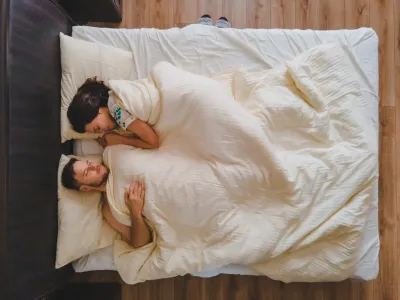Common Challenges of Sharing a Bed with a Partner
Ana Marie Schick: Resident Sleep Expert & Certified Health Coach • Sep 06, 2024

Key Takeaways
- Sleep Struggles: Sharing a bed often means different sleep needs—temperature, mattress firmness, and bedtime habits can clash, leading to restless nights.
- Temperature Troubles: One partner runs hot, the other cold. Dual-zone cooling systems like the Chilipad Dock Pro can keep both sides comfy all night.
- Movement Matters: Tossing, turning, or snoring can wake the other partner. Adjustable setups or white noise can help minimize disruptions.
- Routine Sync: Differing sleep schedules—like early birds vs. night owls—can cause friction. Establish shared quiet hours for better rest harmony.
- Better Solutions: Communication and the right tech can fix most sleep conflicts, turning “bedtime battles” into peaceful, uninterrupted sleep.
Sharing a bed with a partner can be a wonderful experience, but it can also present challenges when it comes to getting a good night's sleep. From having different sleep schedules – one person as an early bird, the other as a night owl – to varying preferences for temperature or mattress firmness, there are many reasons why sleep quality might suffer when you share a bed.
Did You Know: 75% of Americans reported that sharing a bed with their partner has a negative effect on their sleep quality. [1]
However, with a few simple strategies and adjustments, you can improve the quality of your sleep and wake up feeling refreshed. Below, we will explore some practical tips on how to sleep better when sharing a bed.
Common Challenges of Sharing a Bed
Sharing a bed with a partner can be a wonderful experience, but it can also present challenges that affect sleep.
Here are some common issues and their impacts when sharing the same bed:
Different Sleep Schedules
When partners have different sleep schedules, it can lead to disturbances and can impact their varying bedtimes and wake-up times.
For instance, one partner may be a night owl, staying up late, while the other may be an early bird, waking up at the crack of dawn. This misalignment can result in one partner being disturbed by the other’s activities, such as turning on lights, moving around, or making noise.
Over time, these disturbances can lead to frustration and decreased sleep duration for both individuals, resulting in less restorative sleep.
Related Blog: Understanding Shift Work Sleep Disorder
Conflicting Preferences for Bedroom Temperature
Couples often find themselves at odds over the ideal bedroom temperature. One person may prefer a toasty, warm environment, while the other craves the cool, refreshing chill of a lower setting.
This clash in preferences can quickly turn into a nightly battle over the thermostat, leaving both feeling frustrated and sleep-deprived. Discomfort due to the temperature can lead to frequent awakenings throughout the night, further disrupting sleep.
On top of that, the argument itself can create tension, making it difficult to wind down and peacefully fall asleep. This frustration not only affects the quality of sleep but also spills over into the next day, affecting mood and overall well-being.
Related Blog: Benefits of Sleeping in a Cold Room

Helping Couples Achieve Personalized Sleep Comfort
Our bed cooling systems offer the perfect solution for couples! With personalized temperature settings, you can each enjoy your ideal sleep climate, ensuring restful, uninterrupted sleep.
Disruptions Caused by Snoring and Sleep Disorders
It's no surprise that snoring is a common issue among couples sharing a bed and can be a significant source of sleep disruption. It can range from mild to loud and chronic, making it difficult for the non-snoring bed partner to get quality sleep.
Loud snoring, often an underlying symptom of various ailments or disorders, such as obstructive sleep apnea (OSA), can be a source of distress. OSA is a serious condition in which breathing repeatedly stops and starts during sleep. [2]
Did You Know: Around 39 million adults in the United States are affected by obstructive sleep apnea (OSA). [3]

Restless Movements: Tosses and Turns
Some individuals move a lot during their sleep for various reasons, such as restless legs syndrome, vivid dreams, or simply being light sleepers.
For example, someone might lie in bed, concerned that any movement or change in their sleep position could disturb their partner, resulting in restless sleep or, even worse, staying awake for an extended period.
These movements can be disruptive, causing the other partner to wake up multiple times during the night. As a result, it can lead to a restless night's sleep for both partners, leaving them feeling tired and irritable the next day.
Space and Comfort: Beds Too Small or Uncomfortable
Sharing a bed that is too small can lead to a lack of personal space, making it difficult for both partners to get comfortable. This can cause both physical and emotional discomfort, leading to poor sleep quality.
Also, an uncomfortable mattress that does not adequately support the body or inappropriate pillows that do not provide proper neck support can contribute to back pain, neck pain, and overall restlessness.
Rejuvenating sleep depends on giving ample space for each person to move comfortably and selecting a mattress and pillows that deliver necessary support and comfort.
Clashing Sleep Habits
When bedtime routines don’t match up, both partners pay the price. One person might swear by falling asleep to late-night TV, while the other needs total silence and darkness. Inconsistent sleep hygiene can significantly impact the quality of sleep for both partners, especially when their bedtime habits differ.
Screens make it worse. Blue light from TVs and phones messes with melatonin—the hormone that signals it’s time to wind down—making it harder to drift off and stay asleep. Add in the noise, flickering lights, or endless scroll of “just one more video,” and both partners end up wired instead of relaxed.
Over time, these mismatched habits can lead to poor sleep quality, dependency on TV or phones to doze off, and even tension in the relationship. In fact, a National Sleep Foundation poll found that 60% of Americans watch TV right before bed, [4] and an LG survey showed 61% fall asleep with it still on. [5]
What should you do? Talk it out. Open conversations about sleep preferences go a long way. Simple compromises—such as using headphones, setting a shut-off time, or swapping screen time for something calming that you both enjoy (like reading)—can help maintain peace in the bedroom and promote better rest for both of you.
Unequal Bed Sharing
Ah, the starfish sleep position. This is the partner who, perhaps unintentionally, takes up more than their fair share of the bed, leaving their significant other clinging to the edge or squeezed into a small part of the mattress.
This nightly struggle for space can be disruptive and exasperating.
The sprawling sleeper may be unaware of it, while the squeezed partner feels resentful and deprived of sleep. This can be especially troublesome for those who already have difficulty sleeping or need a certain amount of space to feel at ease to fall asleep.
Related Blog: The Scandinavian Sleep Method is a simple yet effective solution for couples seeking better rest. By using two individual comforters instead of sharing one, each partner can maintain their own ideal temperature and avoid disturbances from tossing and turning—leading to a more peaceful, uninterrupted night’s sleep.

The Pet Dilemma: Furry Friends in Bed
Many couples find it comforting and enjoyable to snuggle with their furry companions in bed, basking in their warmth and companionship. However, having pets in bed can have both positive and negative aspects.
Pets can be disruptive sleepers, often moving around, scratching, and even dreaming, which can disturb the sleep of their human companions. Pets tend to occupy a lot of space on the bed, leaving less room for the couple to sleep comfortably.
This can create a crowded sleeping environment, making it difficult for both individuals to find a restful position.
Lastly, pets can put off a lot of body heat which in turn significantly increases bed temperatures making it very disruptive to the quality of sleep for their owners.
Sleep Study: Not all cat or dog owners choose to let their pets sleep in their bed, but a study conducted by the American Academy of Sleep Medicine revealed that around 46% of pet owners actually snuggle up with their pets in bed. [6]
Benefits of Sharing a Bed with Your Partner
Sure, bunking up with someone new can throw your sleep off at first—but once you sync up, the perks kick in. Research shows plenty of couples actually sleep better together than apart. [7]
And it’s not just about the cozy, romantic side of things. Sleeping next to your partner and keeping the same schedule can come with some real benefits worth noting.
- Deeper, better sleep – Sharing a bed can actually improve sleep quality once you’re in sync.
- More energy – Restful nights mean more fuel for the day ahead.
- Quicker drift-off – Falling asleep feels easier with someone by your side.
- Stronger connection – Co-sleeping can boost intimacy and relationship health.
- Brighter mood – Good rest helps keep irritability in check.
- Overall wellness – Consistent, quality sleep supports long-term health.
Sharing a bed can set the stage for better sleep by creating a sense of calm, safety, and comfort, both in your environment and in your relationship. Deeper sleep doesn’t just leave you more rested; it can lift your mood, sharpen emotional balance, and make communication with your partner smoother.
Conclusion
Sharing a bed isn’t always a dream—different schedules, snoring, temperature battles, and midnight tossing can all get in the way of good sleep. Left unchecked, these disruptions chip away at rest and well-being.
But it doesn’t have to lead to a “sleep divorce.” Talking openly about your needs, dialing in the right bedroom temp, choosing a mattress that works for both, and keeping consistent sleep habits can make all the difference.
When couples prioritize both personal comfort and shared routines, they get the best of both worlds: deeper rest, stronger connection, and mornings that actually feel refreshing.
Common FAQs
Why Do I Struggle to Sleep in the Same Bed as My Partner
If your partner does anything that disturbs the bedroom environment, such as leaving on bright lights, making noise, or moving around excessively, it can lead to fragmented and non-restorative sleep, which can result in chronic sleep deprivation.
Why Is It Hard for Me to Share a Bed?
Sharing a bed can be challenging because partners often have different sleep needs, such as varying temperature preferences, sleep positions, and movement during the night. One person may prefer a cooler environment while the other likes warmth, or one partner may be a restless sleeper, causing disturbances. Differences in sleep schedules, snoring, or even mattress comfort can also make it difficult to get quality sleep.
References
[1] Lee, Jasmin. “Sleep and Relationship in the U.S. (2020 Data) - Each night, 6 July 2022.View Resource
[2] Mayo Clinic. “Obstructive Sleep Apnea - Symptoms and Causes.” Mayo Clinic, 14 July 2023. View Resource
[3] Ling, ND, CNS, Vanessa. “Sleep Apnea Statistics and Facts | NCOA.org.” National Council on Aging, 8 May 2024.
[4] Gradisar M, Wolfson AR, Harvey AG, Hale L, Rosenberg R, Czeisler CA. The sleep and technology use of Americans: findings from the National Sleep Foundation's 2011 Sleep in America poll. J Clin Sleep Med. 2013 Dec 15;9(12):1291-9. doi: 10.5664/jcsm.3272. PMID: 24340291; PMCID: PMC3836340
[5] Achauer, Hilary . “Why Are We All Still Watching TV Right before Bed?” Sleep Foundation, 7 July 2022. View Resource
[6] Celmer, Lynn. “Survey: Almost Half of Americans Sleep with Pets.” American Academy of Sleep Medicine – Association for Sleep Clinicians and Researchers, 7 June 2022. View Resource
[7] Fuentes, Brandon, et al. “0010 Bed Sharing versus Sleeping Alone Associated with Sleep Health and Mental Health.” Sleep, vol. 45, no. Supplement_1, 25 May 2022, pp. A4–A4. View Study









